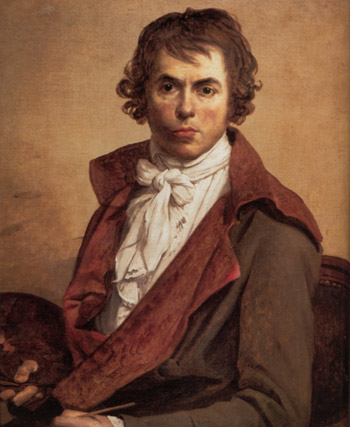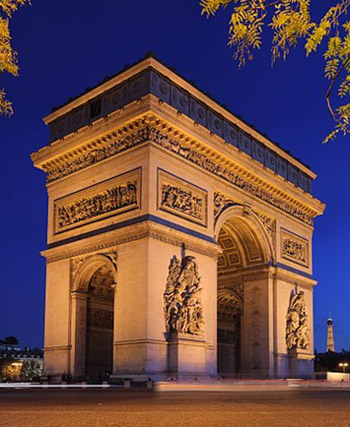The era shifts to the arts and literature of ancient Greece and Rome. Creativity and imagination bring achievements. Humanist scholars concerned about mankind are exalted. Painters begin to use worldly images in their work. Literacy among the secular world begins when the printing press is invented in Europe in the 15th century. North America is a beneficiary. See the recreated Gutenberg printing press at The International Printing Museum.
Jacques-Louis David (1748-1825) is born into a prosperous family in Paris. When his dad is killed in a duel, his mother arranges for nine-year-old Jacques to live with two uncles, both of whom are architects.
After four failures in the official competitions at the Royal Academy, now the Louvre Museum, and years of discouragement, David finally receives a government scholarship that not only provides a stay in Italy, but practically guarantees him lucrative commissions in France.
In Italy, David examines masterpieces and explores ruins. He fills twelve sketchbooks with material he refers to for the rest of his life.
David is an example of a politically committed artist because he favors the execution of King Louis XVI. During the French Revolution, his stance drives a wedge between him and his ex-wife-a Royalist; even so, Marguerite pleads for his release when he is arrested by revolutionary allies. Later, the couple remarry.
David does not recover from being hit by a carriage leaving a theatre in Brussels with Marguerite. The murder of the King prevents him being buried in France.

Renaissance, Neoclassical Romantic movement (1750-1860) reacts against the self-importance of the Rococo movement, in the 18th century. The new movement gives expression to a cult of civic virtues, self-sacrifice, and devotion to duty, honesty, and austerity.
The Triumphal Arch, one of the most famous monuments in Paris, honors those who fought and died for France in the French Revolutionary, and Napoleonic Wars.
According to the Stanford Encyclopedia of Philosophy, “The philosopher Socrates remains, as he was in his lifetime (469-399 B.C.E.) an enigma, an inscrutable individual. Despite having written nothing, he is considered one of the handfuls of philosophers who forever changed how philosophy was to be conceived.”
"All of our information about him is second-hand and most of it vigorously disputed, although, his trial and death, at the hands of the Athenian democracy, is nevertheless the founding myth of the academic discipline of philosophy."
Go on to Describe, Analyze, Interpret & Conclude. Contact me for help.

The Death of Socrates (1787.Oil on canvas. 51 x 77 in. (130 x 196 cm.) is in the official 1787 Salon exhibition of the Académie des Beaux-Arts in Paris, even so, David is not honored by a royal "works of encouragement."
The Greek government accuses Socrates of denying the gods and corrupting the young through his teachings. He is offered the choice of renouncing his beliefs or being sentenced to death. David’s extensive research portrays Socrates discussing immortality of the soul.
You see him strong and calm and at peace while grieving friends lament the event. The stoic Socrates thanks Asclepius, the God of health, for the hemlock brew which will ensure a peaceful death. Plato sits at the end of the bed.
Disdained for her weakness, Socrates' wife is seen grieving alone outside the chamber. Critics compare this painting with the Sistine Chapel ceiling painted by Michelangelo.
Citizens, both men and women, living in ancient Rome, wore Togas to symbolize the gods and goddesses they worshipped. Here, David gets into trouble when he scoffs at them.
This statue of Demosthenes, at the Vatican in Rome, illustrates the draping of clothing worn by the figures.